Menus
- Post-classic queen
- 915 cc parallel-twin, 90 hp, steel subframe, 167 kg
- Discovery
- In the saddle
- Test
- Braking
- Cycle part
- Conclusion
Post-classic queen
915 cc parallel-twin, 90 hp, steel subframe, 167 kg
It’s been 20 years since the last Laverda left the brand’s factories, but the brand still has its fans around the world and especially in Australia, especially for its racing success.. Because it is all the same this twin which made it possible to break the pawn to the Honda four and to the British Triple, in particular to the Championship of old Australian. Yes my daughter lives in Australia so I spend several months there every year which also explains some really good summer motorcycle testing there..
And I regret that there are not more Italian motorcycles in this championship, to rub shoulders with the Japanese four cylinders and the Irving Vincent, relaunching the fight between these road sports dating from the beginnings of the Superbike. But it wasn’t always like that. Because in 2001, Ken Watson beat Japanese motorcycles, Triumph three cylinders as well as Ducati’s Desmo V-Twins and other two-stroke to win the Australian Post-Classic Championship title on a Laverda SFC parallel twin. it must be said that it was not just any Laverda either, but a preparation carried out by Chris Cutler, owner of the bike and former GP sidecar rider Pete Campbell.
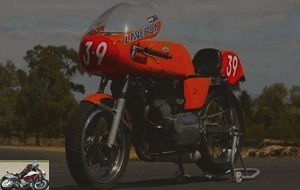 Laverda 915 SFC review
Laverda 915 SFC review
Discovery
The bike that started this journey was one of two Laverda 750 SFCs imported to Australia in 1972 and ridden by Vic Vassella for three seasons in Production, F750 and Unlimited. The machine regularly finished in the top three with occasional victories. Yet after being disqualified from second place in an Unlimited race at Amaroo Park for being pinned using the start button while pushing the bike, Vassella said he was actually penalized for riding a more advanced bike. technically. He was referring to the fact that few other motorcycles of the time benefited from an electric starter and that the regulations did not explicitly prohibit its use..
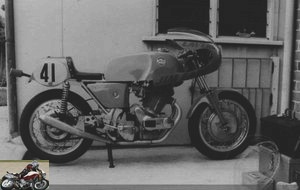 The Laverda SFC 750 delivered in 1972 to Jim Eade
The Laverda SFC 750 delivered in 1972 to Jim Eade
After three racing seasons, the Laverda began to lose its competitive edge against the opposition of increasingly reliable two-strokes and the new, larger-engine Kawasaki Z900s. Vassella then returned the Laverda to the garage in 1975 to sell it to Chris Cutler, a New Zealand metallurgical consultant now residing in Cape Town, South Africa:
I rode it on the road a bit until 1995 when I decided it wasn’t good enough to use anymore so I took it apart and rebuilt it completely..
While restoring the Laverda, Cutler brought it into line for the Australian TT, a race contested on the public roads of Port Kembla, NSW, in the spring of 1996. Vic Vassella had initially agreed to reassemble on the bike before reconsidering the idea and especially the dangerousness of this road circuit. It was Ken Watson, a seasoned 70s / 80s road racer who had great success in Malaysia, who finally volunteered for the race after seeing the restoration of the SFC.
Ken finished second in the Post Classic category, but with the original SFC drum brake. He drove a few more laps and said "look, we have to make this thing go faster". It was indeed pretty standard, so we ran it on methanol and grafted a Ceriani four-cam brake into it, it was better. We then finished on the podium with around 65 horsepower at the rear wheel. However, if it braked well, it didn’t turn as fast anymore due to the 28 ° tilt steering geometry, which took a toll on Ken’s riding style. I didn’t agree to cut out a very nice original bike so we decided to build a replica of the frame, but with a different geometry. This is how it all started.
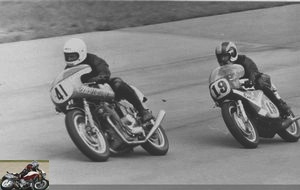 Vic Vassella facing Dave Burgress on Suzuki TR500 at Amaroo Park
Vic Vassella facing Dave Burgress on Suzuki TR500 at Amaroo Park
Starting with the Laverda 750 SF frame, Cutler hired Pete Campbell to design a motorcycle around it, first by replicating the extra bracing of the SFC frame and reducing the caster angle to 24 ° with a caster. reduced to 95 mm by means of triple tees specially designed to visually reproduce the original Laverda and to please homologation agents. A vintage-style swingarm would later solve the original Laverda’s breakage problem with that extra torque from the new engine, providing here a much shorter wheelbase of 1,435mm compared to the 1,470mm of the 750 SFC. This also helped boost the performance of the now much more powerful engine. Credit goes to Chris Dowde, an engineer from Wollongong who used a stock of spare parts that Cutler had assembled over the years..
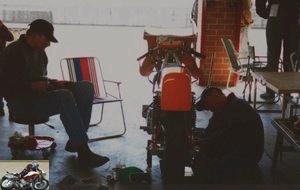 Chris Cutler and Peter Campbell tuning the Laverda in Oran Park
Chris Cutler and Peter Campbell tuning the Laverda in Oran Park
The original dimensions of 80 x 74 mm of the 744 cm3 engine were first increased to 874 cm3 using an SF750 crankshaft built by Brook Henry, specialist in V2 Ducati, who made it lighter by machining it this way. than by installing connecting rods from Ducati 900SS and modified pistons from Suzuki SP370. Combined with a largely modified cylinder head, which was then trimmed to provide a compression ratio of 12.5: 1, this methanol engine then delivered 87 hp at 7,800 rpm. 40mm Dell’Orto PHM carburettors were installed and valve dimensions significantly increased to reach 47mm at the intake and 40mm at the exhaust (compared to the original 41.5 and 35.5mm).
This increase in power was transmitted through a new camshaft manufactured by Ivan Tighe Cams in Queensland, driven by a chain with aluminum sprockets and a modified V2 Jaguar tensioner..
The cams look nothing like an SFC and they don’t look like anything else. They were very cleverly imagined by computer software which gave a very strange valve timing, but it brings a lot of acceleration, even if it consumes a lot of fuel. !
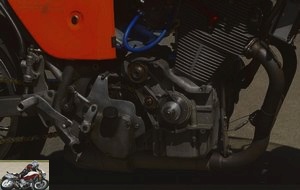 The Laverda engine was revised to 874 cm3 and then to 915 cm3 a few years later
The Laverda engine was revised to 874 cm3 and then to 915 cm3 a few years later
To handle the extra horsepower, Cutler concocted a five-speed gearbox combining SF and SFC shafts with gears specifically designed to shorten the highest ratios. This gearbox was matched with a wet clutch designed for endurance racing. The primary chain drive proved to be problematic and a primary belt was not much better as it spun in oil and overheated. Pete Campbel’s 2-into-1 exhaust thought of as a dirt-track item turned out to give 5 more horsepower than the vintage racing exhaust.
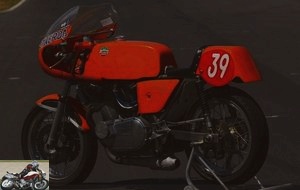 The very open silencer takes place under the engine
The very open silencer takes place under the engine
To make sure the new frame offered the improved handling he was aiming for, Cutler contacted Ron Williams, Maxton suspension wizard from the UK and got a pair of Koni aluminum body shocks and a new set of parts. internal for the 38mm Marzocchi fork that Campbel had recovered from a Ducati before adapting it to the geometry of the bike and the weight of Ken Watson. The dry weight of the Laverda EVO had been reduced to 167 kg, including oil. Removing the electric starter, the alternator and the battery had reduced the weight by 20 kg. To brake this Laverda, Campbell installed a pair of 280mm Scarab rotors from an MV Agusta up front and a 230mm Kawasaki rotor at the rear, each bitten by an AP-Lockheed caliper. However, the eligibility committee ruled that the rear disc did not correspond to the Post-Classic period, so it gave way to a small 125mm single cam drum taken from a Honda trial..
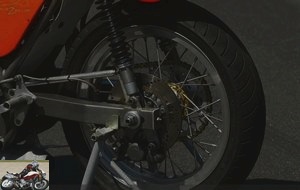 Initially, the drums were replaced by discs at the front and at the rear.
Initially, the drums were replaced by discs at the front and at the rear.
Making its debut at the Australian TT at Bathurst at Easter 2000, the now much-improved Laverda twin gave Ken Watson an immediate take on the Honda T-Rexs that have so far dominated the Unlimited Post-Classic class and get a second-place hat-trick between Greg Johnson and Rex Wolfenden.
In Bathurst we ran on gasoline because after finishing the bike two weeks earlier, we wanted to run it there. Having a rear disc brake propelled us into the pre-1980 Forgotten Era class, but Ken managed to finish second against more modern bikes with bigger engines like the Suzuki GSX-R 1100 and Honda CB1100R..
In Watson’s hands, the Laverda was now a favorite in Australian Post-Classic races, winning numerous races over the next two years before losing a valve at the Island Classic in January 2001. That’s when the decision was made to push it up to 915cc with Wiseco 87mm bore pistons. A choice which made it possible to push the power to 90 horsepower, to gain more torque and also to run on methanol. La Laverda then took center stage. That year, Watson won the Australian Post Classic title at Winton by defeating Honda, Triumph and Ducati. The fruits of victory also brought the seeds of defeat…
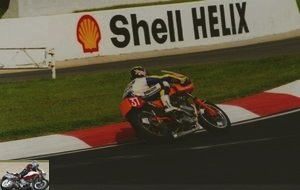 Ken Watson in Bathurst on SFC
Ken Watson in Bathurst on SFC
There was always a persistent belief at Honda that they would be better than us at Phillip Island. So in January 2002 we took the bike over there to the Island Classic with Ken going all out to show them that Winton wasn’t just luck. We were faster than the Hondas in the first two series, but there was a new contender in the form of a three-cylinder Yamaha 500 that won the first race, ahead of Ken and the SFC. Peter Guest’s new 1,003cc Triumph Trident won the second race after struggling in the first and we were still second as the Yamaha retired. But in the third race it was our turn and the primary chain broke. Ken was pissed off and said he wouldn’t get on the bike again until it got 20 more horsepower, which obviously wasn’t doable on an engine that was already delivering 50% more power. The bike was built for him and everything he wanted was on it, so rather than looking for another rider we decided to stop there.
Chris Cutler’s decision meant that at the end of the season the 915 SFC Replica he and Pete Campbell had built, along with several shiploads of parts, would be sold. It was Steve Battisson, a passionate scientific researcher of Laverda from Canberra who bought it. The man already had half a dozen Laverda’s and had contracted the Breganze virus from his father. Culter continued to pilot the ex-Vassella 750SFC on the road for a few years until his job took him to Zambia. Inevitably, it was again Battisson who bought it.
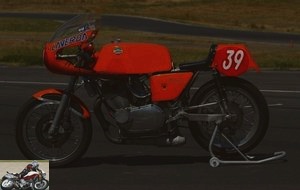 La Laverda 915 SFC
La Laverda 915 SFC
In the saddle
The opportunity to renew my track experience aboard a Twin Laverda, for the first time in more than three decades since the 580cc Ogier Laverda TT2 victorious at Daytona in 1984, presented itself at the Broadford circuit. north of Melbourne. I also had the chance to ride for the first time on the restoration of the ex-Vassella 750 SFC from 1972. The time was above all to discover what is surely the fastest and most powerful twin Laverda ever built. Steve Battisson had reassembled the primary transmission by belt on this version and a shorter fiberglass fairing on the aluminum fuel tank. A choice that offered a riding position more related to the bike than the typical lying position of Latin motorcycles of the early 80s like the SFC that I had just ridden.
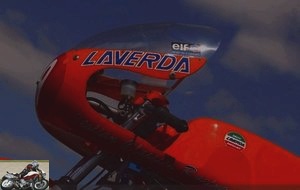 The more open fairing offers more comfort to the SFC
The more open fairing offers more comfort to the SFC
The saddle is very low, so using the rear brake would have been difficult even if I wanted to, but Ken Watson apparently never did either, so I guess that’s fine. However, all of that means it feels like a real part of the bike, genuinely rooted inside and being able to hide behind the short bubble in the two Broadford straights, even for me being a bit older. taller than Ken. The Veglia counter shifted to the left shows a famous, but fake, red zone at 10,000 rpm, so it should be read with 2,000 rpm less, the real engine limit being actually at 8,000 rpm with a maximum power of 90 horsepower at 7,800 rpm. You don’t always have to rely on instruments !
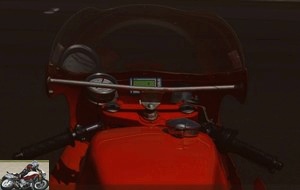 If the counter goes up to 10,000 revolutions, it indicates a value 2,000 revolutions higher than the reality.
If the counter goes up to 10,000 revolutions, it indicates a value 2,000 revolutions higher than the reality.
Test
What an engine! Turn it on and the hoarse growl emanating from the steel exhausts ending in an aluminum muffler placed under the engine makes the Laverda sound completely different from any other motorcycle. It is not even comparable to a parallel Norton or Triumph twin set at 360 °.
Pressing the gear selector with your left foot reveals a crisp, precise action that allows you to set off without almost having to touch the clutch lever. It is therefore as easy as it is fast, although there is only a moderate feeling of torque intended to favor handling over performance. The lightweight crankshaft assembly allows the engine to move up through the rev range almost effortlessly. It’s not a four-stroke twin masquerading as a two-stroke; so the towers climb quickly and cleanly, rather than through abrupt throttle response.
 The 915 SFC is easy to handle
The 915 SFC is easy to handle
The moderate but consistent torque curve means it takes a lot of clutch play to keep the Laverda in pace, especially in the first gears. In addition, there is an astonishing gap between second and third, marking a slowdown in acceleration, which is not as transparent as it should be. But unlike any other parallel twin on which I have been able to ride and particularly in comparison to the SFC ex-Vassella which vibrates more and more as we go up in speed, only a few tingling on the highest revs are felt at through the footrests in fourth.
The clean, well-tuned carburation provided by the 40mm Dell’Orto delivers a powerful boost from 3,000 rpm (actual, not on the meter), with an extra kick when hitting the 5,000 rpm mark. You have to rev up to keep the engine on the right dynamics and be rewarded, in the slower corners, with exceptional acceleration for a parallel twin from the 70s. It ultimately looks like a much more modern motorcycle than what it is there. is written on the label. The Laverda quickly escapes from a curve if you keep the counter above 5,000 rpm (7,000 on the tachometer), strong enough in any case to push the Avon AM23 back 130/70 to its limits. The Laverda propels itself out of Broadford’s first corner uphill in second gear, accelerating hard with the handlebars gently swaying in the hands with each turn as the front wheel heaves up under speed while one is still leaned to the right, with the rear Avon seeking grip. However, everything remains controllable and without the slightest trace of highside. Impressive !
 You have to play with the clutch to take full advantage of the 90 horsepower
You have to play with the clutch to take full advantage of the 90 horsepower
Indeed, the steering of the Laverda seems very precise by the standards of the time, proving that the revised geometry by Cutler meets all the criteria in terms of agility coupled with stability under braking. This allows for clean and easy cornering with strong braking at the end of the straight line, where it is necessary to maintain the brakes in the right turn downhill, with all the risks of locking the front wheel that this entails. if the motorcycle has not been properly adjusted. Still, the SFC 915 allows it to be done with a great sense of control thanks to the added leverage offered by the wide straps. These also help turn the machine from angle to angle through Esses on the downhill and launch into the blind left that leads to the straight. Even when arriving quickly, the Laverda stays riveted to its path, without losing the front when the revs resume their ascent. Even if you are a little wrong, it is possible to correct your trajectory without losing too much momentum thanks to a very responsive steering.
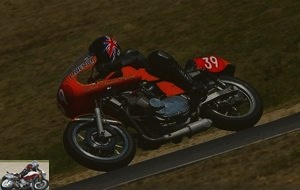 Maneuverability remains the strong point of the Laverda 915 SFC
Maneuverability remains the strong point of the Laverda 915 SFC
Braking
A mid-session inspection showed that I was pushing too hard for both tires, especially the front Avon AM22 with the rubber linting on the shoulders. The Laverda feels small and nimble, especially compared to the longer Ducati v-twins it would compete against, or even the bulkier and heavier Honda and Triumph. However, I was surprised that it didn’t brake as well as a Ducati 750SS which, although 10kg heavier, offered more bite with identical Lockheed calipers biting off 280mm Brembo rotors of the same size as the ones. of the SFC Scarabs. Maybe it’s a matter of platelets ?
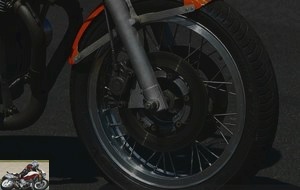 The front brakes lack a bit of bite compared to a Ducati 750SS with the same calipers.
The front brakes lack a bit of bite compared to a Ducati 750SS with the same calipers.
Cycle part
One feature betrays the Laverda’s age, however, and that’s how she reacts to Broadford’s multiple bumps. The Koni shocks reviewed by Maxton do not provide enough damping to keep the wheel on the ground all the time despite my extra weight on Ken Watson. On the smoother sections, they absorb power well to the sound of this unique exhaust. The tone transforms into a sort of howl at high revs, sounding like the motorcycle equivalent of a howling wolf at the moon before going hunting Honda…
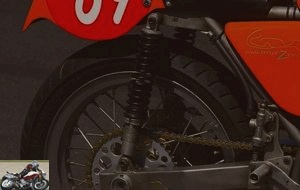 Koni shocks show their limits on bumpy sections
Koni shocks show their limits on bumpy sections
Conclusion
After a decade of absence from the circuits, the Laverda 915 SFC has once again ventured into this field. At the Eastern Creek Festival of Speed, New South Wales’ premier historic motorcycle gathering, Steve Battisson handed the keys to the bike to rider Drmsby Middleton to ride the bike for the first time since purchase from Cutler in 2002:
We raced in a Club event to prepare, then in Forgotten Era 1300 and New Era 750 where we find the first GSX-R 750 etc. We took pole position and won two out of three wins on our debut. The only failure was when Drmsby stalled on the starting grid for the 3rd race, but he still managed to finish first in the category. We then went to Barry Sheene to face bigger opposition like T-Rex Honda and Ducati Robert Young, but we still won the Post-Classic Unlimited category there..
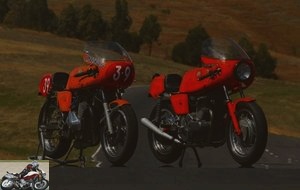 The Laverda 915 SFC and the original 750 SFC
The Laverda 915 SFC and the original 750 SFC
So, for its return to Down Under Post-Classic racing, the Laverda 915 SFC found itself where many fans in the category expected it: on the top step of the podium. Australian ingenuity applied to the classic Italian base transformed a motorcycle long considered suitable only for endurance into a particularly effective weapon for speed racing..
Strong points
- Motor
- Agility
- A unique motorcycle
Weak points
- Braking
- Rear shock absorbers
The technical sheet of the Laverda 915 SFC
Related articles
-
Martin Kawasaki 1230 Motorcycle Test
The faithful friend 4 Z1000 cylinders rebored to 1,229 cm3, 144 hp, Moto Martin frame, 175 kg dry Many of us have had motorcycles that have become…
-
Ducati 350 SCD motorcycle test
From the circuit to the road for the Italian sportswoman 4-stroke single cylinder, 340 cc, 42 hp, 210 km / h, 112 kg dry In 1954, the arrival of Fabio…
-
Ducati Monster 620 motorcycle test
Biker testing: Garfield Ducati and me, it’s a long platonic love story. Between in high school in the late 80s, the teenager I was did not fail to swoon…
-
Aprilia Tuono 1000 Factory Pikes Peak motorcycle test
Survive and win V4 at 65 ° of 1.078 cm3, 170 hp, 170 kg, victory and record at the Pikes Peak Motorcycle racing is inherently perilous, but there aren’t…
-
Curtiss P40 Warhawk Final Edition motorcycle test
First and last 2.163 cc V-Twin, 156 hp and 217 Nm, 247 kg full made, $ 75,000 Curtiss Motorcycle Co. , named after legendary American biker and aviation…
-
Ducati Panigale V4 S motorcycle test
The price of the exception V4, 1103 cm3, 214 hp and 124 Nm, 195 kg all full facts, 28,890 euros The bike that was being born was obviously exceptional:…
-
Triumph Daytona 955i motorcycle test
Centenial Edition – English elegance GSX-R1000, R1, CBR 900 … There are the hyper-sports which are always on the front of the stage and then there are…
-
Yamaha RZV 500R motorcycle test
GP 500 2 stroke … road ! 50 ° V4, 494 cc, 100 hp, 134 kg Sports bikers are familiar with the Yamaha RD 500 LC, inspired by Kenny Roberts’ YZR500….
-
MV Agusta Superveloce 800 motorcycle test
Neo-retro in the right tempo 3 cylinders of 798 cm3, 148 hp, 88 Nm, 173 kg, 20,300 euros Concept bike adapted in an ultra exclusive limited series, the…
-
Homemade hotrod 649cc Triumph twin, Norton Manx clutch and fork, 48hp, 129kg dry Superbike racing and its Supersport derivative are largely responsible…
y annoys me, y annoys me, y annoys me !
Well it depends. For a truck, that’s fair …
Me too !
Well, see very well, but a little expensive and beware of the maintenance cost at Ducati, it will overshadow its big sister on the 1260, which is still much more expensive, on the 950, the engine is already more than sufficient in my opinion
Indeed it was time for this Multitrada to have a makeover. I remember a comparison with the BMW S1000. A comparison in the form of a boxing match. Stunned every round, the BMW ended up knocking out its Italian rival …
Well then Waboo, we let some shells go ?
"win 46 cm ground clearance "

Woaw, enough to greatly improve the crossing abilities
"No more desmodromic belts then"
("no more belts or desmodromic timing", I guess )
)
I may be saying something stupid, but it seems to me that on the Ducati "top of the range" engine, the belts have disappeared since the 1199, right?
Thank you for this very well done test !
A few remarks, you consider this bike to be a great traveler, okay, suddenly I find it unfortunate that Ducati did not take the opportunity to install the new Regina maintenance-free chain.
Another thing, you speak of the Aprilia V4, but you could have mentioned the 1200 V4 of the Honda Crosstourer, or that of the VFR 800 X, if indeed the second does not box in the same category, we must not forget that 1200 came out 175hp in version F.
When I see this Multistrada I tell myself that Honda has missed something for not having made its maxi Trail evolve. !
Honda is aiming for mass while Ducati is aiming for the elite.